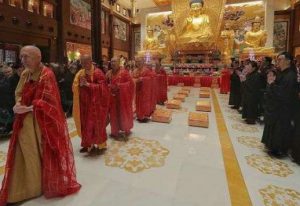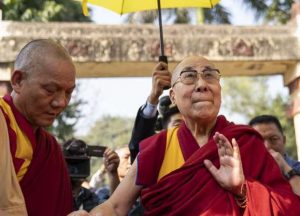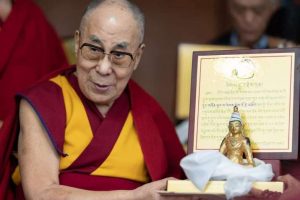
In fall 2007, in the company of Venerable Tsoknyi Rinpoche and a group of his students, photographer Michael Ash made a pilgrimage across Tibet to Mount Kailash, the sacred mountain in Western Tibet revered by Tibetan Buddhists as the most auspicious pilgrimage place one can visit in one’s lifetime. During the course of this three-week journey, again and again he found himself inspired by a vision: to create a collective of Buddhist practitioner-photographers whose artwork could be used for the altruistic purpose of supporting the activities of different Dharma organizations around the world.
Over the next few years, the inspiration crystallized; Ash’s intent to build a platform where Buddhist photographers could come together was developed and, step by step, practically realized. In 2012, the Dharma Eye website was launched, with this primary intent integrated into its core: 25 per cent of all proceeds from the sale of images are donated directly to Dharma Eye’s rotating Featured Cause of the Month.

This year, Dharma Eye has grown substantially. Since receiving guidance and blessings from both Tsoknyi Rinpoche and Kyabje Dilgo Khyentse Yangsi Rinpoche in Kathmandu, Nepal, at Losar (Tibetan New Year), Dharma Eye has added many new photographers to the core collective and completely redesigned the web platform that supports its activities. As the momentum behind the vision grew significantly, the dream became real.
Now Dharma Eye has available over 600 stunning images with content that includes Buddhist sacred sites; extensive images of HH the Dalai Lama at teachings and empowerments around the world; glimpses of the daily life and rituals of Tibetan Buddhist nuns; evocative documentary work from travels by the collective’s members; and a new gallery of portraits of some of the most dynamic teachers of today by photographer Olivier Adam, whose gentle and warm eye has attracted much attention from those who have become familiar with Dharma Eye’s work. In July, German photographer Victoria Knobloch joined the collective, complementing its collection with her elegant, soft, evocative black-and-white galleries.

A very special presence among Dharma Eye’s photographers is the monk Tenzing Rikksang, one of Dilgo Khyentse Yangsi Rinpoche’s primary attendants, whose images were offered to Dharma Eye by Khyentse Yangsi himself. His “Images of Devotion” gallery displays a subtle eye, great artistic skill, and most of all a heart full of devotion towards his teacher, with all profits from his gallery going directly to support the activities of Dilgo Khyentse Yangsi and his monastery, Shechen.
“We are really pleased with the photographers we represent,” says Ash. “Each is unique, and all have a very human quality. They are real, warm human beings who are engaged in practice in their own ways and whose work reflects their character and the way they view and experience the world. This is something I felt was missing previously; whereas there has been such tremendous Dharma art over the centuries, it was often—at least in Tibet—by practicing monks or laymen supported by monastic institutions. So what to do for the numerous practitioners today who might lack a proper channel or support for the artistic reflections arising from their engagement in the path? As the Dharma spreads around the world, entering into new cultural and social as well as modern economic contexts, it seemed that new platforms to support this extension were called for.”
An important element of Dharma Eye is that its focus is not exclusively on subjects that are Buddhist; it is more about a unique quality of seeing—the quality of “eye” that artists have when their work springs from committed practice. While a good part of the photographers’ work indeed focuses on Buddhist subjects, they all have images, whether detailed or reflective, that are more an expression of the way they see the world. From the lush, exquisite portraits and still lifes of Russian-born, Scotland-based Lera Grant-Evdokimova, to the reflective, inquiring scenes of Tadas Juras to the iconoclastic views by Finnish Risto Kuulasmaa, the dynamic range of images Dharma Eye features offers something for every taste.
Among the Featured Causes of the Month that Dharma Eye has supported or has plans to support are the Tsoknyi Nepal Nuns; 84000: Translating the Words of the Buddha; Karuna-Shechen; The Yogini Project; Shechen Monastery; and Bodhi Seeds, which represent the altruistic activities of Tsoknyi Rinpoche, Dzongsar Khyentse Rinpoche, Matthieu Ricard, Dilgo Khyentse Yangsi and Shechen Rabjam Rinpoches, and Dzogchen Ponlop Rinpoche.

So what’s next for Dharma Eye? “Well, we have several new photographers we are presently dialoguing with who we are looking to integrate by the end of 2014,” says Ash. “And then coming up in 2015, we have a series of images by our artists illustrating a new book on Shantideva’s Way of the Bodhisattva being published in the spring by Wisdom Publications in the US. From there, we are making preparations to set up a few exhibits in Europe in the summer, and then Asia in the fall. We are looking for sponsors for these exhibits now, as they can be very significant events to raise funds for the causes we support.”

To see more about Dharma Eye’s photographers and their art and projects, as well as the Buddhist causes whose activities they support, please visit the Dharma Eye website.















